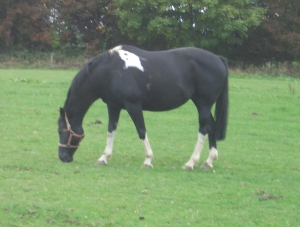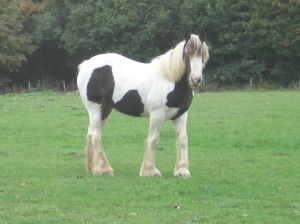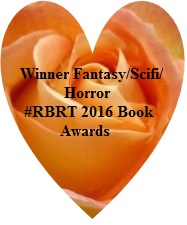Do you remember the film, NATIONAL VELVET?
Do you also remember that the horse in that film was called, ‘THE PIE’?
Have you ever wondered why such an odd name for a horse?
I guess the film makers just couldn’t find the appropriately coloured horse for the part, so they went with a SOLID COLOURED horse, instead of the PIEBALD colour described in the book.
So what exactly is a piebald?
Very simple – a horse that has a coat colour of BLACK AND WHITE patches.
The guy in the foreground is PIEBALD – nothing but black and white whereas the fella behind is actually a TRICOLOUR – brown, black and white (more on him in another post).
Piebalds may have a lot of colour with very little white
or a lot of white and less colour
Whatever the proportions, the defining fact is that they have only the two colours, black and white, in their coats.
They come under the umbrella classification of COLOURED HORSES, and I’ll cover the other varieties in another post.
Have you seen any horses with colours you can’t describe? Let me know, and I’ll give you the correct term for it.


























So, what’s the difference between a ‘pinto’ and a ‘piebald’? Aren’t pintos black and white, too? Don’t forget, I’m a yankee ‘city slicker.’ However, in my defense and many moons ago, I did take Horsemanship in college and learned how to ride English. I belong to a online horse forum just so I don’t make errors when it comes to the horses in my novels. 🙂
LikeLike
Hi Cynthia, thanks for dropping in 🙂
Pinto is defined as ‘large patches of white and any other colour’.
I guess this is where we come across a continental difference – in Europe we make a clear distinction: black and white is piebald; white and any other colour is SKEWBALD (my next post!). We don’t have pinto as a recognised colour.
So it looks like the US pinto includes both, whereas we make a clear distinction..
To add complication, there seem to be more coat colour variations in US breeds than in European horses, so I guess the details in your books must reflect the region of the world where the action takes place.
LikeLike
No pinto? We also call them “Paint” over here. Paint horses are strictly regulated to fit inside the American Paint Horse Association requirements: http://www.horsechannel.com/horse-exclusives/paint-vs-pinto.aspx
There are other associations that fit for horses that fit the “Paint Horse” requirements dealing with bloodline, they are listed in the article above and have their own bloodlines.
The APHA recognizes various colour patterns: press.apha.com/pdfs/guidebooks/ColorGenGuide.pdf
There is also the Medicine Hat Paint: http://www.examiner.com/article/the-united-states-medicine-hat-horse-association which I grew up with.
Overall, give me a PAINT HORSE!! Gorgeous…… 😉
LikeLike
Wow, thanks for all the links Leiah – lots more places for writers to go get correct US definitions 🙂
I grew up with what we call coloureds, and even now am on a yard that specialises in coloured show horses of all shapes and sizes; I just love them 😀
LikeLike
I am JEALOUS! Maybe you can post some photos…
wink wink, nudge, nudge!
LikeLike
More people should know the correct, old-fashioned definition of ‘piebald’. It describes the color pattern of only black and white on any animal; especially when referring to a horse.
LikeLike
That’s true, but some of these terms are falling into disuse in the modern world.
LikeLike